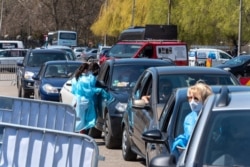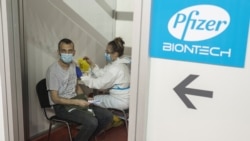On April 23, Sputnik V, the COVID-19 vaccine developed by Russia’s Gamaleya Research Institute of Epidemiology and Microbiology, sent out a tweet suggesting a higher mortality rate for those who received the Pfizer-BioNTech vaccine versus those who received AstraZeneca’s.
“#SputnikV study shows that there are significantly more deaths following vaccination with Pfizer than with AstraZeneca vaccine per 1mn administered doses, based on official publicly available data by 13 international health regulators,” the tweet read.
In subsequent tweets, Gamaleya said these “major” death rate discrepancies “should be the focus of honest scientific and public discussion.” In another tweet, Gamaleya said “the media should be covering facts and avoiding biases.”
Follow-up tweets on April 26 took an even more aggressive tone.
“Can EU media still be silent on data that average deaths among Pfizer vaccine recipients is much higher than of AstraZeneca’s? Is it easier to publish fake stories that Sputnik V is propaganda rather than report the real data from official regulators?” one tweet read.
Another accused “big Pharma” of "trying to hide” this vaccination data, even though the Sputnik-manufacturer itself was citing publicly available sources. It further accused the pharmaceutical industry of “pressuring media not to report it.”
Gamaleya’s characterization of the data is egregiously misleading and essentially false.
First, Gamaleya is adding up deaths across all causes for vaccine recipients; in other words, the deaths aren’t necessarily linked to COVID-19 or vaccination.
The institute stated as much in its tweets, even as it raises doubts.
One of the slides tweeted by Gamaleya comes with the “important note” stating: “Data includes all reported deaths with and without vaccine SAE (serious adverse event) trigger suspicion, including caused by COVID-19.”
Another note states “no clear link” has been established between vaccinations and deaths.
Next, Gamaleya fails to conduct statistical stratification — that is, arranging the data into sets that accounts for factors such as an individual’s health profile, age, sex or other attributes known to affect risk of death.
Nor is geographical consistency in the data. Of the 13 countries Gamaleya listed, only seven provide both the AstraZeneca and Pfizer vaccines. Population sizes for the recipients of different vaccines is also unequal.
According to Gamaleya’s data, more doses of Pfizer have been administered in the U.S. alone than doses of AstraZeneca in all the other mentioned countries (excluding Russia) combined.
Gamaleya fails to note how different restrictions in the seven states where both vaccines were administered affects who can and cannot receive them. For example, authorities in Austria, Denmark, France, Germany, Norway, and Spain have previously limited the AstraZeneca vaccine to people under 65.
On the other hand, the Italian Medicine Agency recommended those aged 55 and over, or with other health risks, receive the Pfizer or Moderna vaccine rather than AstraZeneca’s.
Several European countries, including France, Germany, Italy and Spain, also temporarily suspended use of the AstraZeneca vaccine after reports of rare blood clots.
Since Gamaleya reported all post-vaccination deaths regardless of cause, the link between age and mortality is crucial. According to the U.S. Centers for Disease Control, three-fourths of all COVID-19 deaths in the United States are among those aged 65 and older.
Many global vaccine rollouts have specifically focused on higher-risk populations, including those aged over 80 and/or living in long-term care facilities.
Therefore, death tallies that do not account for the age or underlying health conditions of vaccine recipients will be skewed.
For example, according to Gamaleya, the country with the highest deaths per 1 million Pfizer doses is Norway. The country also made headlines when 23 elderly people died after taking the Pfizer/BioNTech vaccine in January.
Although Russian state broadcaster RT reported that at least 13 of those died “due to side effects of the Pfizer/BioNTech Covid-19 vaccine,” Norwegian medical authorities said it had not been determined that the vaccines were to blame.
As noted by Reuters, however, many of those vaccinated in Norwegian care homes have “serious underlying diseases,” and 400 people die weekly in such facilities.
That means it is likely some of those vaccinated will die later from unrelated causes.
By contrast, in the U.K., where the Pfizer and AstraZeneca vaccines are in use without risk restrictions, Gamaleya reports 24.1 deaths per million doses administered for AstraZeneca versus 20.4 million deaths per million doses administered for Pfizer.
Again, those deaths have not been attributed to vaccination and include mortality for all causes in vaccinated people. The figures are not adjusted for age, sex, ethnicity, and health profile, as noted above.
On a separate but related note, the Hungarian government has also suggested that Russian and Chinese-developed COVID-19 vaccines are safer than Pfizer. But that comparison, too, was based on unadjusted data for demographics or health.
The Hungarian Medical Chamber said the information provided by the government was "unfit to establish efficacy differences of various vaccines,” Reuters reported.
Reuters further noted that Hungary is the only European Union country to authorize and deploy Russian and Chinese vaccines without approval from the EU drug regulator, while the country’s prime minister, Viktor Orban, has “cultivated strong ties with both Russia and China.”
U.S. officials have previously accused Russian intelligence of running disinformation campaigns to undermine faith in the Pfizer vaccine.
Polygraph.info previously noted that the state-owned Russian Gazette published an article in February claiming 64 people in Sweden had died from side effects of the Pfizer vaccine, despite the fact that Sweden’s medical watchdog found that none of the deaths were vaccine-related.
A study by The Alliance for Securing Democracy, which is affiliated with the German Marshall Fund of the United States, found that “Pfizer received by far the most unfavorable coverage of any vaccine, particularly from Kremlin-funded outlets and Iranian state media and government accounts.”







